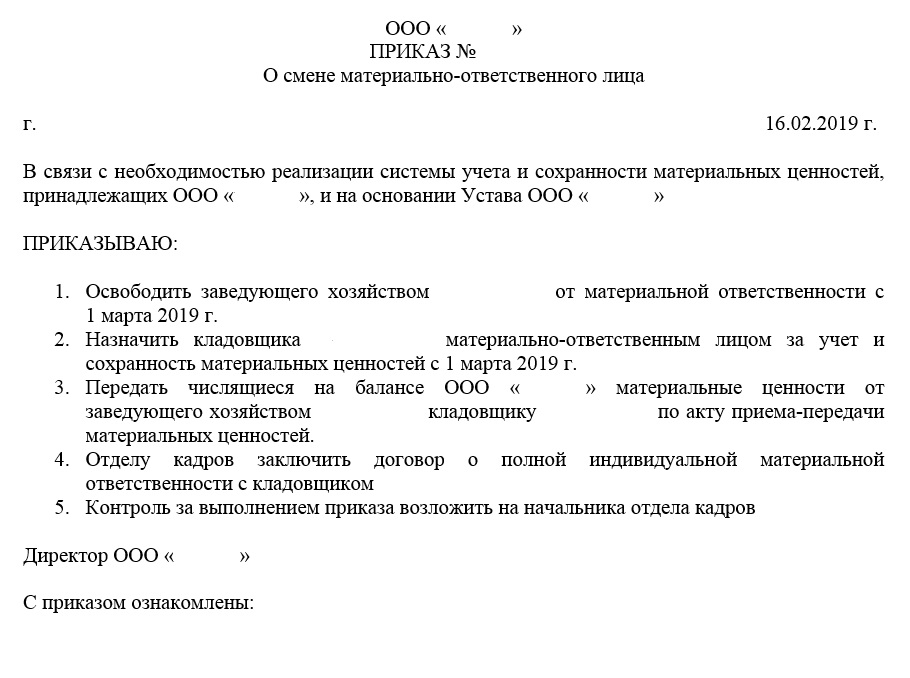The materially responsible persons are represented by employees of the company who, during the performance of work duties, are responsible for various values belonging to the organization. Therefore, with them when drawing up a labor contract, an agreement on liability is concluded. This leads to certain difficulties in terminating the employment relationship with them. Dismissal of a materially responsible person can be carried out on the initiative of the head of the company, direct employee or on the basis of an agreement of the parties. In each situation, there are certain nuances and features.
The concept of materially responsible persons
These employees during the performance of labor duties are responsible for the preservation of various values belonging to the company. Usually they are represented by controllers, department heads, storekeepers, cashiers, pharmacists, as well as lockers.
Such employees are held liable if, for various reasons, harm is done to the values trusted by the company. Since under such conditions, the enterprise suffers certain damage, the employee must cover it at the expense of personal money.

The nuances of holding accountable
Responsible persons are held liable only under the following conditions:
- there is evidence that the company was damaged by specific actions;
- the fact of damage is recorded in official documentation;
- there is a specific relationship between the actions of the employee and shortage;
- correctly calculated the amount of this damage.
The dismissal of a materially responsible person is considered a complex process compared to the termination of employment with other employees of the enterprise. This is due to the need for an inventory, which will confirm that during the work of this specialist, no damage was caused to the company.
Ways to terminate the contract
Dismissal of a materially responsible person can be carried out in three different ways. These include:
- on the basis of an application written independently by an employee of the company who wishes to retire, change his place of employment or for other reasons leave the company;
- on the initiative of the head of the enterprise, but there must be good reasons for this, for example, regular fixing of disciplinary offenses, reduction of staff or the emergence of various disagreements with a specific hired specialist;
- on the basis of an agreement of the parties, for which two parties to the transaction draw up a corresponding agreement, which sets out all the conditions for termination of cooperation.
An employment contract is often terminated after its expiration. The dismissal procedure is carried out under general conditions, but there are some distinctive features. For example, an employee must transfer all the values entrusted to him for safekeeping with another employee within two weeks of training.
If the materially responsible person is dismissed of his own free will, then he must work for at least two weeks in the company, so that the head of the company finds a suitable employee to transfer the values to him. In addition, an inventory is carried out and a special act is drawn up, which indicates that the parties have no complaints against each other.

Types of liability
The rules for dismissal of a materially responsible person additionally depend on what form of responsibility a hired specialist has. It can be presented in the following varieties:
- Partial Under such conditions, if an employee inflicts damage to the company, the amount of compensation depends on the average monthly income of a citizen.
- Complete. In the event of a situation when damage is caused to the company, the employee pays compensation equal to this damage, so it does not matter what salary he receives. But full responsibility can only be transferred to a limited number of employees, which include chief accountants, cashiers, or heads of different departments.
Information on the type of liability is certainly prescribed directly in the employment contract. If it is proved that the employee intentionally harmed the company, even with partial liability he will have to fully cover all the damage.

Dismissal process
The procedure for dismissing a materially responsible person is to implement the following steps:
- inventory taking;
- drawing up an act of acceptance and transfer of values;
- publication of the order by the leader.
Each stage of this process has its own unique features.
Inventory
An inventory of the dismissal of a materially responsible person is a mandatory procedure. Its main goal is to identify the shortage, which will allow the employee to be held accountable if his guilt is proved. This process must be attended by a directly dismissed employee. If another person has already been found for this position, then he is involved in this procedure.
The inventory process is divided into successive stages:
- initially, the head of the company issues an order on the need for an inventory;
- a commission is being formed whose members are engaged in direct verification of values;
- on the basis of the procedure performed, an act on the results is drawn up, and certainly 3 copies are required, since two documents are transferred to the materially responsible person, and the other copy is sent to accounting;
- if as a result of this procedure any violations, inconsistencies or other problems are detected, an appropriate inventory is generated;
- if a shortage is identified, a written explanation is drawn up by the employee;
- the amount of damage is calculated;
- a special resolution is drawn up by the head of the company, on the basis of which funds are collected from the employee to cover the damage.
According to the Labor Code of the Russian Federation, the dismissal of a materially responsible person without inventory can be challenged. It is with the help of this check that it is possible to identify whether an employee of the company has caused damage to the company. Additionally, the new employee can be sure that the mistakes of the past specialist will not be translated into him. The term for the dismissal of a materially responsible person can be delayed only during a complex inventory.

Drawing up an act of acceptance of the object
This document is a confirmation that all the values under the responsibility of the employee were transferred to a new employee of the enterprise. The following information shall be entered into this act:
- Date of preparation;
- information on two parties, therefore, the full name of the responsible person is indicated, as well as the name and details of the company;
- the period during which the citizen was responsible for certain values owned by the enterprise;
- the name of all transferred property, and its value must be additionally indicated.
At the time of writing this document, not only the dismissed employee should participate, but also a new employee holding a vacant post.
Rules for issuing an order
The dismissal of the materially responsible person should be executed in a standard way, for which a corresponding order is issued by the head of the company. Its content depends on who initiates the termination of employment.
If the employee independently filed for dismissal, then the details of this document are indicated in the order for the dismissal of the materially responsible person. The order must be signed by the head of the company, as well as a direct worker should familiarize himself with it.
After the issuance of the order, the necessary information is entered into the workbook of the employee of the enterprise. It is transferred to the specialist only on the day of dismissal, together with all necessary payments. This includes not only salary, but also compensation for all previously unused vacation.

What documents are made out?
The dismissal of the materially responsible person at their own request or at the initiative of the employer should be carried out in the correct sequence of actions and with the preparation of certain mandatory documentation. It refers to:
- a letter of resignation or notice of termination of employment drawn up by the employer;
- order;
- a workbook, which contains information about the reason for dismissal, the date of termination of the relationship, as well as a link to a specific article of the Labor Code, depending on the basis of this process;
- Act on the transfer of material assets;
- act of inventory.
Each document must be reviewed by the dismissed employee. An application for the dismissal of a materially responsible person must be submitted to the head of the company 2 weeks before the termination of employment. During this period, all necessary actions are performed by the management of the company. Often, an inventory takes a little less time, so the employer may ask for an extension of the working period, but does not have the right to insist on such a decision by the employee. Additionally, the employee can write a written permit to conduct an audit without his participation if he trusts the management of the company.

The nuances of dismissing an employee of his own free will
The dismissal of a materially responsible person of their own free will occurs quite often. In this case, the nuances are taken into account:
- two weeks before the termination of employment, the employee draws up a letter of resignation;
- an inventory is taken during this period;
- all values that were held by the employee are transferred to another employee of the enterprise;
- even if the transfer of property is not completed, the employer does not have the right to detain a citizen for longer than the prescribed two weeks;
- on the last day of work, the citizen is given his work book, and all the necessary funds are paid.
The employee may ask the employer to dismiss him without practicing, if there are good reasons for this. Under such conditions, the management of the company conducts an inventory in the absence of a responsible person. But even such conditions cannot be a reason for refusing to hold an employee accountable.
What to do if it is not possible to find a replacement?
There are frequent situations when it is impossible to transfer cases when the materially responsible person is dismissed, since the head of the company could not find a new employee. In this case, another employee of the company is vested with the appropriate authority.
Additionally, it is possible to accept the values as the direct manager of the entire company or individual branch. For this, the act of reception and transmission is compiled competently.

Conclusion
Dismissal of a materially responsible person is carried out in a standard way, but at the same time one has to face some nuances. These include the need for an inventory and transfer of property to a new employee of the company.
If in 2 weeks it is not possible to find a replacement, then the property can be taken by the head of the company. If a shortage is detected as a result of an inventory, then the laid-off worker must cover the damage at the expense of personal funds.
